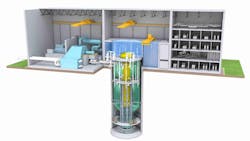Utility-Scale Small Nuclear: TVA & AEP Exploring SMR Projects for Future Plants
Several of the nation’s biggest utilities are looking to a potential new resource, small modular reactor (SMR) nuclear energy, as a path forward to meet daunting future load from data centers, reshoring industrial and transportation electrification customers.
The Tennessee Valley Authority (TVA) and American Electric Power (AEP) together are seeking strong financial footing and federal funding to pursue SMR and advanced reactor projects. SMRs have not yet been built or deployed, but they would offer smaller and less expensive nuclear power compared with conventional reactor plants currently in operation.
Federal agency TVA is leading an $800 million application from the U.S. Department of Energy's Generation III+ Small Modular Reactor Program with a coalition of partners, including Bechtel, BWX Technologies (BWXT), Duke Energy, Electric Power Research Institute (EPRI), GE Hitachi Nuclear Energy (GEH), Indiana Michigan Power - an AEP Company, Oak Ridge Associated Universities, Sargent & Lundy, Scot Forge and North American Forgemasters, the state of Tennessee and other utilities and advanced nuclear project developers.
In 2024, Congress created a grant program to encourage the Gen III+ SMR deployments in the U.S. to strengthen America’s domestic nuclear industry and help meet the growing demand for affordable, reliable, and clean power.
According to Jeff Lyash, TVA President and CEO, the funding will fasten construction of an SMR at TVA’s Clinch River Project, in Oak Ridge, TN, by two years, with commercial operation planned for 2033, once awarded. Along with the partners, TVA is ensuring that the funding not only leads to the deployment of the SMR at Clinch River but also help establish a domestic supply chain and support future deployments of advanced nuclear units in the U.S. and beyond.
More on the Future of Small Modular Reactors
Microsoft and Constellation Agree on Nuclear PPA
Get our free Microgrid Knowledge Nuclear Microgrids E-Book
TVA will work with partners to share lessons and best practices to offset costs and reduce risks for customers, while improvising nuclear technology for the entire country. TVA is following a structured planning process to enhance the Clinch River Project in phases at which the TVA Board will evaluate and consider approving future plans.
While TVA’s Board has not voted to approve an SMR at the nuclear site, the availability of DOE funding will help accelerate the early activities of the project, upon the approval. TVA is pursuing the BWRX-300 technology in the U.S., along with Ontario Power Generation (OPG) in Canada. OPG is also planning to construct the same technology and is expected to be operational by 2029.
TVA is planning for the potential deployment of up to four SMRs at the Clinch River Nuclear site. These deployments will stimulate the supply chain for BWRX-300 reactors in the future.
Moreover, AEP is seeking grants under the US DOE's Generation III+ SMR Program to support the Early Site Permit (ESP) process for two potential SMR sites. Through its Indiana Michigan Power (I&M) operating company, the utility has announced that the property at the Rockport Plant in Spencer County, Indiana, is identified as a potential SMR site. Through its Appalachian Power operating company, AEP is also initiating the ESP process for company-owned Joshua Falls property in Campbell County, Virginia.
Through a grant funding partnership with the TVA and GE Hitachi Nuclear Energy (GEH), I&M is looking for $50 million to start the early stages of SMR development at the Rockport Plant site.
I&M has applied as a subrecipient under TVA's application, with GEH as the reactor technology provider. Appalachian Power has applied under a separate grant category with no technology provider identified at this time.
"The flexibility of our generation portfolio has allowed us to provide reliable, affordable power to our customers," said Steve Baker, I&M president and chief operating officer. "Our fleet includes reliable baseload generation from coal and the Cook Nuclear Plant, as well as renewable energy from wind and solar.”
I&M is also working to extend the operating license for Cook Nuclear Plant in Bridgman, Michigan through 2054 for unit 1 and 2057 for unit 2.
